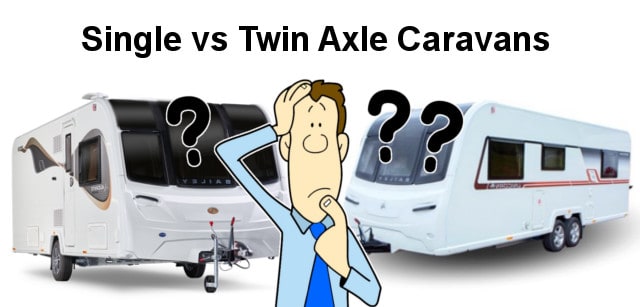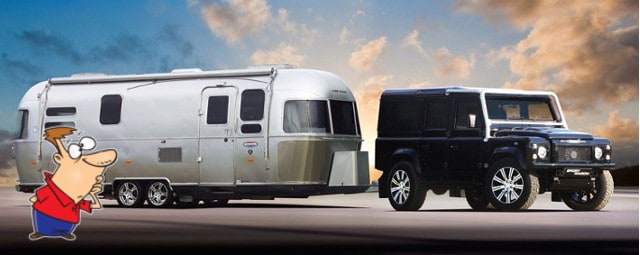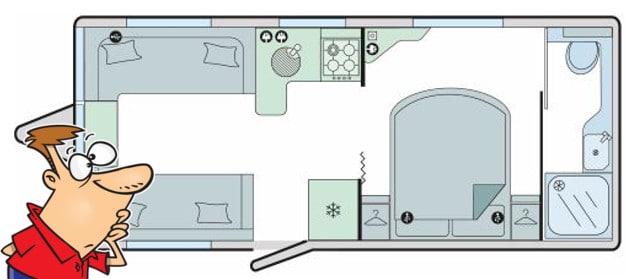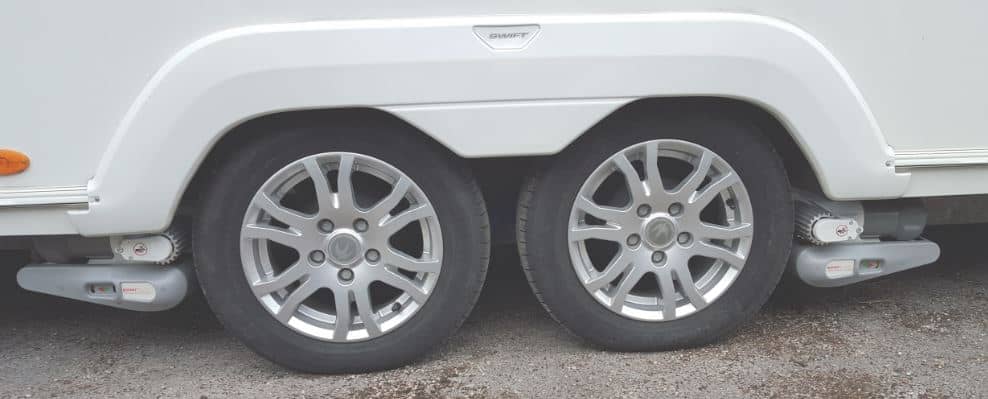
Since opening Horton Common in 2014, I’ve seen hundreds of caravans turn up on-site, both single and twin-axle variants. Furthermore, we have owned a caravan in our family for pretty much all my life. When I’m having conversations with our guests about their new or upcoming caravan purchases, the topic of single vs twin axle caravans sometimes pops up. I’ll sometimes be asked which I think is best. However, from my own observations and the feedback I’ve received from our guests, there is no outright winner between the two.

Both single-axle and twin-axle caravans have their pros and cons. Therefore with this post, I’m going to discuss the different advantages and disadvantages. You will then be able to use that knowledge to help guide your next caravan purchase.
In terms of our own family caravan, we currently own a first-generation Alu-Tech Bailey Pegasus 514. Its a single-axle caravan with a rear washroom and a length of 6.48m.
Hence, its a very long single-axle caravan that has certain implications, and I’ll be referencing those later.
However, please note this post is not intended to be a critique or endorsement of any particular brand/model of caravan.
The content below on single vs twin axles are general comments which are applicable to all makes and models of touring caravans sold in the UK.
Disclaimer: Hey! By the way… any links on this page that lead to products on Amazon or Caravan Guard are affiliate links, and I earn a commission if you make a purchase, with no additional cost to you 🙂
- Dissolves waste and removes odours naturally and has delightful mild fragrance
Want To Visit Horton Common? – Book Here
Table of Contents
Introduction To The Single Axle vs Twin Axle Caravan Debate
It would be remiss of me not to quickly describe the difference between single and twin (double) axle caravans, so here it goes.
With a single-axle caravan, you have one axle and, therefore two wheels. With a twin/double axle caravan, you have four wheels.
To generalise, single-axle caravans are commonly smaller/lighter in weight, whereas twin-axle caravans are typically longer/heavier.
With that being the case, if you read the below and believe that a twin axle is your preferred option, please note they are generally heavier and longer caravans.
Therefore, you need to ask yourself certain questions.
Can You And Your Car Actually Tow A Heavy Twin Axle Caravan?
Is your car actually capable, technically and legally, of towing a heavy twin-axle caravan? First off, you obviously need to check the official tow rating for your vehicle.
This will be in the owner’s manual, but with a quick check online, it will also come up. Secondly, there are other factors to consider with towing a longer/heavier twin-axle caravan.
For instance, factors such as the torque/power output of your tow car, its MPG and traction from the drive system all need to be considered.
I’ve got two posts with my thoughts on the best cars to tow a caravan and the 2WD vs 4WD debate you may also want to read.
Furthermore, as I discuss in my post on caravan weights, if you passed your driving test after 1997, unless you have passed the additional B+E test, it’s unlikely you can legally tow a heavy twin axle caravan.
Update: New rules were brought in late in 2021 (read them here) that mean that all licence holders can now potentially tow a trailer up to 3,500kg.
I wanted to bring up these points first and foremost.
Because I want you to be aware of the circumstances when you may not be able to technically or legally tow a twin-axle caravan, even if you want and can afford one.
Ok, I’ll now get into discussing the actual pros and cons of single vs twin-axle caravans.
Towing Stability – Single vs Twin Axle, Is There Much Of A Difference?
A question that our guests have brought up in the past, and I see in the various caravanning forums are the questions over stability.
In other words, are twin-axle caravans more stable to tow than single-axle caravans?
Based on my own observations with our long single-axle caravan and the comments/feedback from our guests, the answer is it depends.
For instance, with our long single axle caravan in some instances, it does suffer from pitching/bobbing during towing.
What Is Trailer Pitching?
What is pitching? Well, its when the front of the caravan moves up and down during towing. This can pull and push on the car’s tow bar.
Now, we have reduced the number of incidences of pitching while towing over the years by loading our caravan in different ways.
However, part of the issue is due to the length of the caravan being on a single axle. Hence, the axle is the pivot point upon which the seesaw action during pitching occurs.
If the caravan was a twin axle, I do believe that pitching would be less likely.
Why? Well, with a twin axle, there would be a wider pivot point. Hence it would be harder for the caravan to pitch up and down during towing.
Resistance To Air Turbulence/Snaking While Towing
Ok, say you are driving down the motorway. You’re on the inside lane towing the caravan, and you get overtaken by a lorry.
In some instances, quite a bit of air turbulence can be generated where the air bounces off the side of the lorry and pushes into the side of your caravan.
This sideways force on the caravan can potentially cause instability. The caravan may start to pivot side to side on the axle or maybe even move side to side on the road itself, also commonly known as ‘snaking‘.
Well, again, with a twin-axle caravan, you have a larger point of contact with the road.
So all other factors being equal, typically, a twin-axle caravan will provide more resistance to these instability issues compared to a single-axle caravan.
The Weight Of Your Tow Car
Now, reading my comments above, it may appear that twin-axle caravans always provide more stable towing performance. As a general rule, I believe that is true.
However, there are also a lot of other variables at play. For instance, the weight of your tow car is a very important factor.
You may have heard of the 85% ‘rule’ with regards to the tow car/caravan weight relationship. In other words, you want the laden weight of the caravan to be no more than 85% of the car’s kerb weight.
However, it is also generally acknowledged that more experienced caravanners can safely tow a 100% weight match.

The general point is for stable towing, you don’t want the caravan to be heavier than the car. Otherwise, during adverse towing conditions, the tail (caravan) might start wagging the dog (tow car).
Well, as stated above, twin-axle caravans are generally heavier than single-axle caravans.
Hence, even though twin-axle caravans have a larger pivot point in contact with the road to help with resistance against pitching and snaking, that additional weight may be a problem.
In other words, if you are going to choose a heavy twin-axle caravan, you want a tow car with a sufficient weight match.
Modern Tow Cars and Caravan Stability Systems
My above comments on the difference in towing stability between single and twin-axle caravans are really all about physics. In other words, the weights of objects, pivot points, friction etc.
However, we now need to consider electronics and computers. For instance, in my post on caravan stabilisers, I discuss the AL-KO ATC system.
The ATC system electronically assists the caravan brakes to improve caravan stability while towing.

Servicing your caravan stabiliser hitch to keep the friction pads in a good condition is very important for any single or twin axle caravan: Image – Amazon.co.uk
More modern cars now have various electronic stability control systems. Some of them are specifically designed to assist with towing.
We are quite a few years away from an autonomous electric tow car that will drive itself. However, over the coming years, more of these electronic towing stability systems will be introduced.
The takeaway point is that modern tow cars with a modern caravan can really help to bridge the divide between the inherent towing stability differences between single and twin-axle caravans.
Where in many cases, there may be very little difference in towing stability between certain single and twin-axle caravans.
Caravan Tyre Cost/Blowouts – Twin Axle Pros & Cons
Caravan tyre safety is something I’ve discussed a lot in my previous posts. As caravan tyres carry a lot of weight, they are inflated to a higher pressure than car tyres.
Furthermore, caravan tyres often spend a lot of time sitting idle, which creates issues with flat spots.
That’s why I think caravan tyre pressure monitoring is a very good idea, and so do caravan insurance companies.
In reference to this specific post on single vs twin axle caravans, where do caravan tyre blowouts come in?

Whether you are considering a single or twin axle caravan I would definitely encourage you to consider a tyre pressure monitoring system: Image – Amazon.co.uk
Well, with a twin-axle caravan, you obviously have two wheels on either side of the caravan, not just one. Now, if a nail in the road caused a tyre blowout, potentially both tyres on the same side could fail.
However, if only one of the tyres failed, you would have a better chance of keeping the caravan under control compared to a single-axle caravan.
With a twin-axle caravan and a tyre pressure monitoring system, you will have a better chance of avoiding a potentially very nasty accident.
However, with caravans, you should be changing your tyres every five years, no matter the remaining tread depth.
Hence, with a twin-axle caravan, you will be spending double the amount on tyres as you would with a single-axle caravan.
Therefore, with a twin-axle caravan, they not only generally cost more to purchase in the first place, but their upkeep costs are also higher due to the additional tyres.
Caravan Layouts – Single vs Twin Axle Caravans
In my post on caravan layouts, I discuss that a popular option today appears to be the transverse island bed with a rear washroom.
Due to the nature of this layout, it will typically be found on longer caravans more suited to a twin-axle chassis. However, there are single-axle caravans with this layout.
You can get pretty much any layout on both single and twin-axle caravans. However, with a twin axle version, you will generally have a bit more space to move around etc.

Another variable at play though is the growing selection of 8 foot wide caravans.
Hence, where someone may have opted for a longer caravan to get more space, they may now choose to opt for a wider caravan instead.
Now, there is quite a heated debate in the UK caravanning community on how suitable 8-foot wide caravans are for UK roads.
However, you could also make the same argument with regard to very large twin-axle caravans.
My point is that the introduction of more 8-foot wide single-axle caravans means you may not have to opt for a twin axle to get the space you want.
Caravan Payloads & Motor Movers
The above may seem like a bit of an odd title, but all will become clear. With a twin-axle caravan, you will generally find they have a higher payload capacity.
How much more additional weight you can load into a twin-axle caravan over a single axle obviously varies from model to model.
However, its fair to say, as a general rule with a twin-axle caravan, you will be able to carry additional belongings.
Though in some instances, that additional payload capacity can be wiped out if you want to install motor movers.

Its important to note that motor moves have to be deducted from a caravans payload capacity: Image – Amazon.co.uk
As a general rule, its harder to turn a twin-axle caravan over a single-axle caravan. It goes back to my previous comments on pivot points.
While towing that wider pivot point on a twin axle provides more stable towing performance, its a hindrance when it comes to manoeuvrability.
Now many caravanners today choose to have a motor mover fitted. Its just simply so much easier to steer your caravan with a remote control than trying to reverse a caravan.
But with a twin-axle caravan, can you get away with a single motor mover on each side, or do you need a mover for each wheel?

Well, I’ve spoken to a couple of guests over the years about this. From those who have a twin axle caravan and one mover per side to those with a mover per wheel.
Its a pretty clear consensus, for a twin axle caravan for the movers to work properly, you need a mover for each wheel.
But what that also means is additional weight eating into that additional payload capacity.
Hence, with a twin-axle caravan with four motor movers, you may not have the additional payload capacity remaining that you expected.
On the topic of manoeuvrability, it is worth noting that some caravan sites that don’t have a road and hardstanding, like ourselves here at Horton Common, they actually ban twin axle caravans.
Why? Well, the second axle on a tight turn drags. Hence, if the caravan site is just grass, a twin-axle caravan can tear at the surface and churn up the grass. Just something you should be aware of.
Conclusions On Single vs Twin Axle Caravans
So my above comments are not intended to put you off single-axle or twin-axle caravans.
My comments are simply to make you aware that each has its own inherent advantages and disadvantages.
You can then consider the points above when looking at your next caravan to determine if a single-axle caravan or twin-axle caravan will be better for your specific circumstances.
For instance, if you don’t intend to change your tow car, you need to thoroughly consider its capabilities. How heavy is your tow car? Is it powerful enough to tow a heavier twin-axle? etc.
Thanks for reading, I hope you found my comments above on single vs twin axle caravans useful/informative.
I also hope in the near future, you consider coming to visit us here at Horton Common caravan site. 🙂
Want To Visit Horton Common? – Book Here


